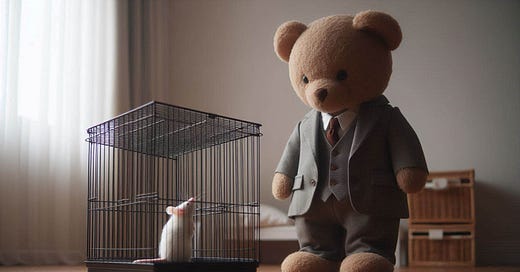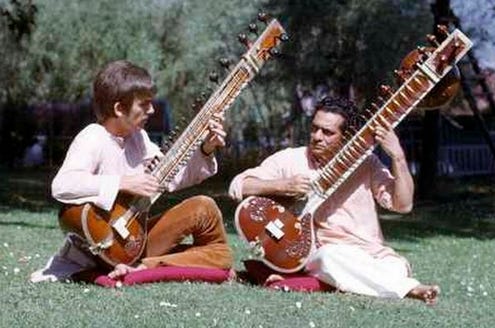In Tropic Thunder (2008), Kirk Lazarus (Robert Downey Jr.) gives a politically incorrect speech about the danger of portraying a character with a cognitive disability if you want to win an Oscar.
Never go full r-----. You don’t buy that, ask Sean Penn. 2001, I Am Sam. ‘Member? Went full r-----, went home empty-handed.
But I guess Kirk’s not so well-versed in Oscars history. In 1968, Cliff Robertson played Charly Gordon, a character with an IQ of 70, and took home the top acting prize.
Perhaps it’s because Charly isn’t intellectually disabled for the whole movie. At first, Charly is bested in puzzles by Algernon, a lab mouse that’s gotten a surgery to make him smarter. Charly undergoes that same surgery, gets some tutoring from Miss Kinnian (Claire Bloom), and becomes a genius.
Though Charly now knows that you can use tantalum and cesium vapor as a thermionic converter, his emotional intelligence hasn’t yet developed. He believes he’s in love with Miss Kinnian and tries to rape her. She fights him off and screams at him, “You think anyone would ever want you? You stupid moron!”
This trippy interlude shows Charly’s path to maturity (spoiler: it’s through motorcycles, drugs, and free love) and, when he returns to the lab, Miss Kinnian is there ready for love. The scientists debut their super-smart Charly at a conference,1 but Charly reveals he’s learned that the effects of the surgery—and his newfound intelligence—are only temporary. The film ends with Charly right where he started, joyous but handicapped.
Rating: 4/10. This is a movie that thinks it’s both smart and wise. It is neither.
Cast and Crew
Cliff Robertson is a Best Actor Oscar winner for this film but he’ll be one-and-done in this column. And honestly, despite his half-century in Hollywood, he hasn’t left much of a legacy. “Jeopardy!” sometimes mentions that he played JFK in the 1963 biopic bomb PT 109.2
But here’s what he’s really remembered for today: he’s Uncle Ben in Spider-Man (2002). You know Uncle Ben: “with great power comes great” yadda yadda. Yeah, Robertson’s name probably Pavlovs to Charly and not much else, but dude’s holding an Oscar and causing frisson in that Spider-Man scene so, y’know, not bad.
Charly is based on the short story-cum-novel “Flowers for Algernon” by Daniel Keyes. It’s epistolary, told as “progress reports” written by Charlie himself. It was initially adapted into “The Two Worlds of Charlie Gordon,” which aired on the United States Steel Hour and starred Cliff Robertson—and, of course, when it was turned into a movie a few years later, Robertson reprised the title role.
Keyes is primarily remembered for “Flowers for Algernon,” but another of his works was recently adapted into a miniseries on Apple TV+. The work was “The Minds of Billy Milligan,” about the first person to ever be acquitted of a crime by pleading dissociative identity disorder, and the miniseries is called “The Crowded Room.” Even though “The Crowded Room” stars Tom Holland and Amanda Seyfried, you probably haven’t seen it because there’s infinite TV to watch.3
The music for Charly was done by the virtuoso sitar player Ravi Shankar. He had previously done soundtrack work on Satyajit Ray’s Apu Trilogy, and we’ll see his work again when we watch Gandhi (1982). In the U.S., Shankar is known for his association with George Harrison, which helped bring sitar music to rock ‘n’ roll.4 Shankar is also the father of Norah Jones, whose bestselling jazz-pop album “Come Away with Me” won the 2003 Grammy for Album of the Year.
Quick Hits:
Claire Bloom co-starred as Charly’s teacher-turned-lover. We’ve seen her in a few other films (Richard III and The Spy Who Came in from the Cold) and have mentioned that she was Rod Steiger’s onetime wife.
Lilia Skala, who played the head nun in Lilies of the Field,5 played a scientist here. Fun fact: Skala was later third-billed in Flashdance (1983).
Dick Van Patten played Bert, another scientist. He’s best known for playing the patriarch on the TV show “Eight is Enough” (1977–1981). That show’s based on the columns of a guy, Tom Braden, who actually had eight kids
and was famous for saying “OH GOD, HELP ME, I HAVE TOO MANY KIDS.”
The Trivia
In Charly, Charly goes on a tour of Boston. His tour guide mentions that the Prudential Tower is “the tallest building in the continental United States, if you consider Manhattan Island outside the continental United States.” So today, we’re talking about some tall stuff.
For most of recorded history, the Great Pyramid of Giza was the tallest structure in the world. That pyramid is said to have been commissioned by the Pharaoh Khufu (also called Cheops) around 2600 BCE. It’s tough to emphasize how long ago “2600 BCE” was. One way it’s sometimes put is that Cleopatra’s birth was closer in time to today than the building of the Great Pyramid was to her birth. I think an easier way to think about it is that basically everything we consider “history” happened after that pyramid was built.6
In the 1300s, after almost 4,000 years, the height of the Great Pyramid was exceeded by a number of European cathedrals. Cathedrals were the tallest structures until the 1880s, when first the Washington Monument and then the Eiffel Tower took that title.
But the game changed with the skyscraper. The skyscraper was invented in Chicago in 1884 when the ten-story Home Insurance Building was constructed using a steel frame instead of load-bearing walls. Let’s cover some of the buildings that have held the record of “tallest building in the world”:
From 1913 to 1929, it was NYC’s Woolworth Building, the headquarters for the F. W. Woolworth Company (an early five-and-dime store). The building was designed in the neo-Gothic style by Cass Gilbert.
The next three record-holders you’ve gotta know are the Chrysler Building (1930–1931, designed by William Van Alen), the Empire State Building (1931–1971), and the World Trade Center (1971–1973). The first two are noted for being in the Art Deco style while the WTC was just called “modern.”
1 WTC was passed in height by Fazlur Rahman Khan’s Sears Tower in Chicago, which used the “bundled tube” design and held the record from 1973 to 1998. The Sears Tower is now known as the Willis Tower7, though I’d recommend only calling it that if you really, really wanna seem like you’re not from Chicago.
The next decade was Asia’s. From 1998 to 2004, the Petronas Towers, designed by starchitect César Pelli and located in Kuala Lumpur, were tallest. You might remember them from the 1999 classic [sic] Entrapment. Then, from 2004 to 2010, Taipei 101 was tallest.
And that gets us to today’s tallest building, the Burj Khalifa in Dubai, UAE. Here’s the Burj Khalifa scene in Mission: Impossible - Ghost Protocol, which is obviously the most important thing about it. It was designed by Adrian Smith, who is also designing the building that’ll one day surpass the height of the Burj Khalifa—Saudi Arabia’s Jeddah Tower.
Anything else? Yeah, be aware of Merdeka 118 in Kuala Lumpur, which is the 2nd-tallest building in the world, and the Makkah Clock Royal Tower in Mecca, which is 4th-tallest. The tallest building in the U.S. is the new One World Trade Center, which opened in 2014.
Speed Round: Boston Sights
Charly takes place in Boston, so here are some of the places that get name-dropped:
Faneuil Hall: A market and meeting place on the Freedom Trail known as “the Cradle of Liberty.” It’s topped with a grasshopper weather vane.
Old North Church. Also called Christ Church, this is where lanterns were to be hung to signal Paul Revere about a British attack. One lantern if by land, two if by sea.
Charles River: the river of Boston, separating it from Cambridge.
Bunker Hill monument. A big-ass obelisk on the site of the Battle of Bunker Hill (i.e., on Breed’s Hill).
Trinity Church. Another Boston church, this one constructed by Henry Hobson Richardson in the 1800s. Hobson is considered part of the trinity of American architecture with Louis Sullivan and Frank Lloyd Wright. Don’t mix this church up with Old North Church or, y’know, any of the many other Trinity Churches.
Odds and Ends
Dumb Charly has a “Fun with Dick and Jane” book…Charly’s room, with its bare walls and no furniture, looks exactly like how my room looked when I lived alone…the tallest statue in the world is the Statue of Unity (and the only statue in the top 50 that’s in the U.S. is the Statue of Liberty, smh)…Considering how Boston of a movie Charly is, do we think Mark Wahlberg could play the title role in a remake?
He condemns modern artists as “dispassionate draftsmen,” refers to foreign policy as “brave new weapons,” calls the youth “joyless, guideless,” and hammers the coming generation as “test-tube conception, laboratory birth, TV education, brave new dreams, brave new hates, brave new wars, a beautifully purposeless process of society suicide.” The scene is trying so hard to show you how smart he is, but it comes off as pandering sloganeering.
Maybe you can remember that he was the lead in the early sci-fi TV show “Rod Brown of the Rocket Rangers” (1953–1954). He also played the Big Kahuna in Gidget (1959) and was in Three Days of the Condor (1975) with Faye Dunaway and Robert Redford. Robertson was also in the TV version of “Days of Wine and Roses,” though Jack Lemmon got the call (and the Oscar nomination) when it was adapted to the big screen.
But maybe you’ve seen the M. Night Shyamalan film Split (2016)? That’s loosely based on the story of Billy Milligan.
Shankar also had a professional relationship with American violinist Yehudi Menuhin. Menuhin is, I dunno, maybe the fourth-most-important violinist to know from the 20th century? But if you’re confident in who Jascha Heifetz, Itzhak Perlman, and Isaac Stern are, then yeah, learn Yehudi Menuhin’s name.
That film was directed by Ralph Nelson, who also directed Charly.
Sure, sure, there’s also, like, Mesopotamia and whatever, but we’re speaking in the broadest of generalities.
It’s named for Willis Group Holdings. Their CEO gave my commencement address. It was fine.










"and, of course, when it was turned into a movie a few years later, Robertson reprised the title role"
Not so "of course"! It was hardly a given; after all, Robertson had previously starred in the TV version of "Days of Wine and Roses" but the feature film recast his role with Jack Lemmon, who went on to get an Oscar nod. That's why Robertson optioned the rights to the teleplay that became "Charly" himself and held on to them for years.
Interestingly, his first wife (Cynthia Stone) had previously been married to Jack Lemmon. I think she might be the only woman who was married to two Best Actor Oscar winners?
His second wife was of course Dina Merrill, who appeared with him on the '60s Batman series as "Calamity Jan" to his "Shame." She was the daughter of Marjorie Merriweather Post, making Robertson a key plank of the MMP Expanded Universe(tm).